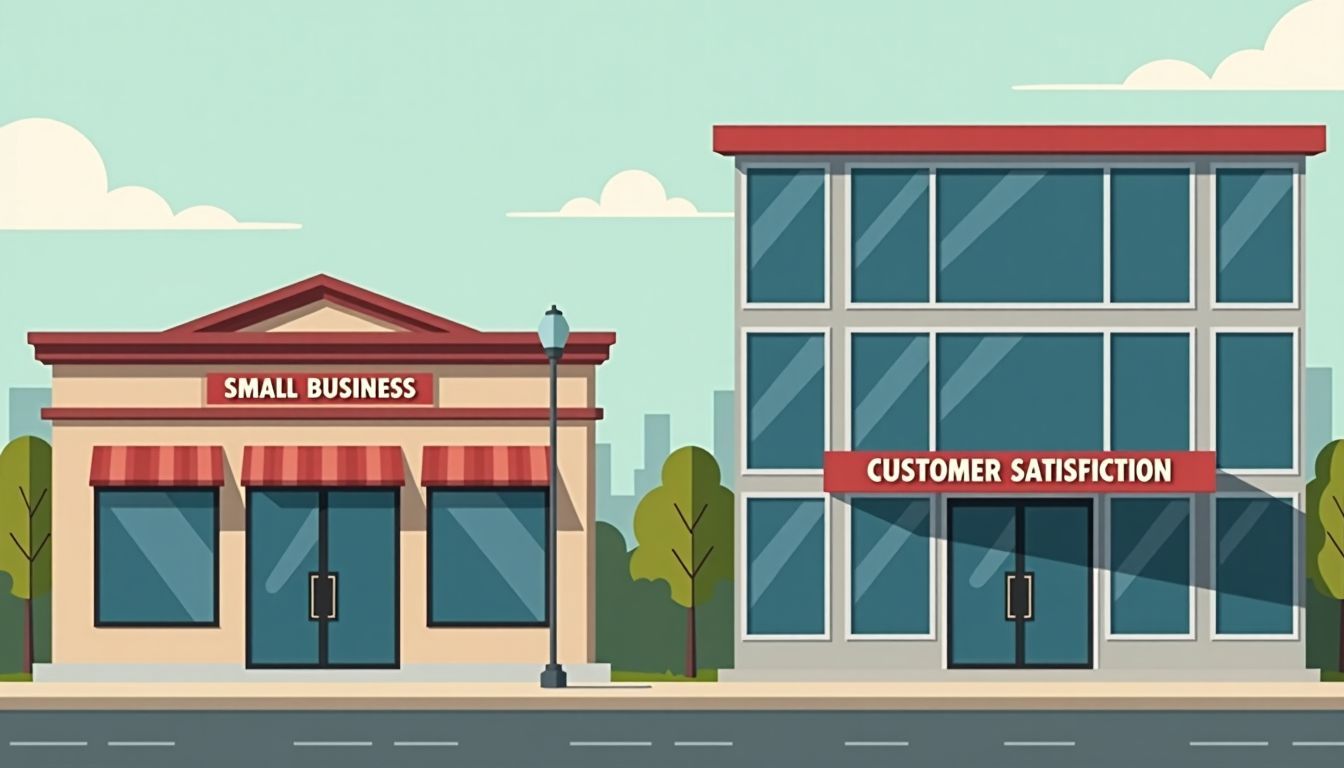Figuring out what makes a good NPS score puzzles many businesses. In 2025, knowing your Net Promoter Score is more important than ever. This article breaks down the benchmarks for a strong NPS and how to achieve them.
Keep reading to learn more!
Key Takeaways
- A good NPS score varies by industry, with technology and healthcare companies often showcasing higher scores due to exceptional customer experiences. For example, tech leaders like NetMotion boast an NPS of 91.
- Geographic differences significantly influence NPS scores. North America demonstrates varying scores across sectors, while in the Asia-Pacific, India shows a high average NPS of 64 versus Japan’s -47.
- Factors such as competition within the industry, customer service quality, and product innovation directly impact a company’s NPS. Firms excelling in these areas tend to have higher scores, indicating stronger customer loyalty and satisfaction.
- Real-time feedback systems and AI-driven analytics are essential for improving NPS. They offer predictive insights that help in adjusting strategies to enhance customer experience effectively.
- Company size affects NPS outcomes; smaller businesses or startups usually achieve higher scores owing to their focused customer engagement practices compared to larger enterprises facing challenges maintaining personalized interactions at scale.
Understanding NPS in 2025

In 2025, comprehending NPS involves gauging both absolute and relative scores to measure customer loyalty. Absolute NPS reflects the direct impact on customer satisfaction and retention, while relative NPS compares companies within specific industries to provide context for benchmarking.
Absolute NPS
Absolute NPS serves as a standard measure for assessing customer loyalty and satisfaction across various sectors. The scale ranges from -100 to 100, with any score over 0 indicating a greater number of promoters than detractors within a company’s customer pool.
This scoring system classifies companies into five separate zones: those with scores between -100 and 0 display negative feedback; scores from 1 to 30 imply an organization requires enhancement; a score in the bracket of 31 to 50 suggests quality experiences offered by businesses; scores from 51 to 70 indicate a strong emphasis on customer advocacy; and lastly, companies achieving scores between 71 and 100 are seen as top runners in cultivating exceptional customer loyalty.
A positive Absolute NPS indicates more than just figures; it showcases a thriving bond between companies and their patrons.
Switching our focus now to Relative NPS provides an added layer of understanding by contrasting these absolute evaluations with industry means, offering context for a company’s true performance within its competitive field.
Relative NPS
Relative NPS allows companies to see how they stack up against their rivals in the same industry. It sheds light on a firm’s market positioning by comparing its net promoter score with those of its competitors.
For accurate comparisons, it’s crucial that all surveys are collected via the same method. This ensures that the data reflects true customer sentiment without any biases caused by differing collection techniques.
Over time, tracking this metric can reveal trends and shifts in how customers view your brand compared to others.
Understanding your position within an industry is just one piece of the puzzle. Next, we delve into specific NPS benchmarks across various sectors, starting with technology and software.
Industry-Specific NPS Benchmarks

Technology and Software, Healthcare, Financial Services, Retail, and Education all have specific NPS benchmarks that businesses in these sectors aim to achieve. Different industries exhibit varying levels of customer satisfaction and loyalty based on their unique market dynamics and customer expectations.
For instance, in the healthcare industry, expectations for quality care and personalized service drive a different set of NPS benchmarks compared to the technology and software sector’s emphasis on innovation and user experience.
Technology and Software
The technology and software sector presents commendable NPS scores, underlining a robust focus on customer satisfaction and loyalty. Frontline companies like NetMotion, Cohesity, Druva, AppDynamics, and Qumulo take pride in NPS scores of 91, 90, 89, 87, and 85 respectively.
These figures illustrate not merely the superiority of their products but the industry’s pledge to offer remarkable customer experiences.
Attaining high NPS scores calls for continuous innovation and consideration of customer feedback, states a leading tech CEO.
These benchmarks establish a lofty criterion for rookie players in the software industry hoping to establish their footprint. It conveys that comprehending customers’ needs and surpassing their anticipations are pivotal to thrive in this challenging field.
Healthcare
Healthcare industry benchmarks for patient satisfaction and loyalty are crucial. The median NPS of 58 reflects the healthcare industry’s performance, with CIMA Hospital boasting an impressive NPS of 96 and International Hospital Corp close behind at 93.
Alliance Healthcare Services, Inc achieved a notable NPS of 90, while Ear Health Wellington Ltd earned an NPS of 86. Understanding these benchmarks is essential for enhancing patient experience and healthcare service quality.
Moving forward to factors influencing NPS scores in this sector, it is vital to consider customer expectations, competition within the industry, and the quality of customer service.
These elements directly impact net promoter scores in the challenging landscape of healthcare. It’s imperative that companies integrate these considerations into their strategies to improve patient satisfaction and loyalty.
Next Up: Factors Influencing Geographic Variations in NPS Scores
Financial Services
Financial services NPS benchmarks reveal crucial insights for industry leaders. The average NPS for financial services stands at 44, indicating room for improvement in customer loyalty and satisfaction within the sector.
Notably, Allianz leads with an outstanding NPS of 79, while Bright Health Group follows closely with a commendable score of 78. These figures underscore the importance of consistently delivering exceptional experiences to clients in areas such as insurance, banking, investment, and wealth management.
As CMOs, founders, and business owners navigate the intricacies of this constantly evolving field, understanding these NPS benchmarks is crucial for driving strategic growth and enhancing customer relationships effectively.
Retail
Retail industry-specific NPS benchmarks are crucial for gauging customer loyalty and satisfaction. The median NPS score is 57, with the lower quartile at 36 and upper quartile at 74.
An excellent range lies above 50, while a good range falls between 0 to 30. Analyzing retail-specific benchmarks offers valuable insights into market standards and competitive positioning within the industry.
By leveraging these performance metrics, companies can refine their customer experience strategies and enhance their overall competitiveness in the retail landscape.
Understanding how NPS scores compare to those of other industries enables businesses to identify areas of improvement more effectively. Utilizing this data allows companies to adapt strategies based on relative measures or standards within the retail field, ensuring an optimal competitive position in the market.
Education
Education holds the 4th position out of 25 industries, with an NPS analysis encompassing 3,690 companies. The top-performing educational organizations achieved an admirable NPS of 5.
As influential figures in various institutions and instructional sectors, CMOs, Founders, and Business Owners may find it important to customize strategies to achieve higher satisfaction levels from students while keeping pace with industry benchmarks.
Delving into the vital comprehension of NPS in educational settings presents an opportunity to enhance customer relationships for academic growth and organizational development.
Factors Influencing NPS Scores

Factors influencing NPS scores include customer expectations, competition within the industry, customer service quality, and product or service innovation. These elements play a crucial role in shaping how customers perceive a company and ultimately affect their likelihood to promote or detract from its brand.
Customer Expectations
Customer expectations play a crucial role in shaping Net Promoter Score (NPS) benchmarks. The constantly changing landscape of customer preferences and demands directly impacts NPS ratings, influencing customer perception, satisfaction, loyalty, and engagement.
Factors such as customer feedback, experience, retention, and service quality are intricately linked to meeting or exceeding customer expectations.
It becomes more and more essential to engage with promoters as their advocacy helps companies maintain high NPS amidst shifting customer expectations. Understanding these dynamics is vital for CMOs, founders, and business owners to ensure that strategies align with the evolving realm of consumer needs and preferences to drive sustainable growth and competitive advantage.
Competition within the Industry
Competition within the industry significantly impacts NPS scores, as market rivalry directly influences customer satisfaction and loyalty. A highly competitive landscape demands companies to focus on building strong customer relationships by delivering exceptional experiences.
Research shows that even with a lower NPS, a company ranked #1 in its industry can still outperform a higher-scoring competitor due to the strength of its customer relationships and loyalty.
Industry ranking and positioning are crucial factors affecting NPS scores, influencing the competitive advantage of businesses. Companies need to navigate the constantly changing realm of competition strategically to maintain or improve their NPS standings amidst heightened market rivalries.
Moreover, understanding and leveraging these dynamics is imperative for businesses seeking continual improvement in their industry performance.
The intense competitive pressures emphasize the importance of understanding how market competition affects customer loyalty and satisfaction levels. In this environment, companies must explore strategies that not only enhance their existing suite but also offer tailored solutions to reveal the secrets of maintaining high NPS rankings amid fierce industry rivalries.
Customer Service Quality
Customer service quality has a substantial impact on NPS scores, directly influencing customer satisfaction and loyalty. The quality of customer support significantly links to feedback management and the overall experience customers have with a product or service.
Enhancing service quality not only boosts NPS but also helps in retaining customers, leading to increased customer retention rates.
Continuously evaluating customer service allows for ongoing progress tracking and identification of areas to enhance the overall experience. Concentrating on improving service quality can effectively strengthen NPS scores, thereby enhancing customer satisfaction and bolstering brand loyalty.
Product or Service Innovation
Highly advanced products and services play a crucial role in shaping NPS scores. Leading-edge innovations drive customer satisfaction and loyalty, ultimately enhancing brand reputation and market share.
A study by McKinsey, for example, revealed that companies excelling in product innovation experienced higher customer retention rates compared to their rivals. As competition intensifies in various industries, maintaining a competitive edge necessitates continuous innovation in products or services.
In addition, groundbreaking offerings often pave the way for an enhanced overall customer experience. Research from Gartner indicates that 89% of businesses now primarily compete based on customer experience, which is significantly impacted by the design of innovative products or services.
By incorporating inventive solutions tailored to meet ever-evolving consumer expectations, companies can effectively bolster their NPS scores through exceptional brand differentiation and unique value propositions.
Geographic Variations in NPS Scores

Geographic variations play a significant role in NPS scores, with cultural and regional differences impacting customer satisfaction and loyalty levels. Understanding these nuances is crucial for businesses operating on a global scale.
To read more about this intriguing topic, delve into the complete article to gain valuable insights.
North America
North America exhibits varying NPS scores across industries. In the healthcare sector, the median NPS stands at 58, reflecting positive patient experience and satisfaction with healthcare facilities.
Conversely, the telecommunications industry records a lower NPS of 31, indicating a need for enhanced customer loyalty and service quality within communication services.
Top performers in North America include NetMotion with an impressive NPS of 91 and CIMA Hospital boasting an outstanding score of 96. These statistics highlight the significance of customer satisfaction and loyalty in driving success within their respective sectors, underlining the pivotal role that high NPS plays in organizational performance.
Europe
NPS scores in Europe tend to be more conservative, with the highest NPS of 100 yet to be achieved. It’s important to note that the average NPS within B2B industries varies from 39 to 76, providing valuable insights into the set standards.
These observations shed light on the intricate terrain of customer satisfaction and loyalty in European markets, offering a crucial roadmap for strategic decision-making by industry leaders and businesses focusing on market analysis and consumer feedback.
Asia-Pacific
Customer sentiment across the Asia-Pacific region shows notable variations in NPS scores. Notably, India boasts the highest average NPS of 64, significantly surpassing Japan’s lowest average NPS of -47.
These substantial differences emphasize the importance of understanding regional distinctions to effectively gauge consumer loyalty and brand perception throughout this diverse market landscape.
Market analysis reveals that there are significant regional differences within the Asia-Pacific countries. For instance, while India demonstrates a notably high average NPS of 64, Japan exhibits the lowest with an average score of -47.
It is crucial for businesses operating in these countries to comprehend these disparities in consumer behavior and sentiment.
Methodologies for Improving NPS

Companies can improve their NPS by integrating customer feedback, engaging in employee training, and optimizing the customer journey. Real-time feedback systems and AI-driven analytics play crucial roles in predictive NPS analysis.
Integrating Customer Feedback
Customer feedback is a critical element for enhancing NPS. The integration of customer feedback entails leveraging various survey methods and response channels to collect data on customer satisfaction.
By utilizing advanced tools for data analysis, businesses can gain valuable insights into the customer experience and effectively improve their NPS.
Moreover, effective surveys should also consider legal and ethical considerations in gathering NPS data, particularly regarding data privacy laws and maintaining ethical communication with respondents.
This ensures that the feedback collection process remains compliant while providing valuable insights for NPS improvement.
Employee Training and Engagement
Employee training and engagement play a pivotal role in influencing the Employee Net Promoter Score (eNPS), which directly measures employee satisfaction and engagement. Training programs, professional development opportunities, and skill enhancement initiatives have been substantiated to significantly impact eNPS by fostering better employee morale and enhancing talent management within an organization.
Moreover, research has shown that companies with robust workforce development strategies tend to achieve higher eNPS scores, leading to improved employee retention and overall performance improvement.
By investing in effective training and engagement activities, businesses can bolster their eNPS, consequently contributing positively to organizational success.
Next heading: “Optimizing the Customer Journey
Optimizing the Customer Journey
To optimize the customer journey and enhance NPS, it is essential to comprehend touchpoints that shape customer experience. Incorporating real-time feedback systems empowers brands with actionable insights, enabling them to proactively address areas of improvement and improve service quality.
Adopting a customer-centric strategy by customizing experiences to meet their expectations fosters stronger loyalty and elevates satisfaction levels.
Customer engagement is pivotal in driving retention. Advanced AI-driven analytics offer predictive NPS capabilities, allowing businesses to predict potential issues before they impact overall satisfaction levels.
By supporting the customer journey with innovative methodologies rooted in thorough data analysis, companies can strengthen their position in a continually evolving landscape of improved customer experience.
NPS and Company Size

Larger companies generally have greater resources to dedicate to customer satisfaction and retention initiatives, potentially resulting in higher NPS scores. Contrasting SMEs with large enterprises demonstrates the impact of scale on NPS and can offer insights into refining strategies for companies of varying sizes.
How Scale Influences NPS
Organizational size significantly impacts NPS, as larger companies may encounter challenges in maintaining high scores due to increased intricacies and operational scale. Startups often demonstrate elevated NPS, attributed to dedicated customer attention, which diminishes upon expansion.
Relative NPS holds greater significance than absolute value, emphasizing industry positioning over universal score thresholds. Cultural differences minimally influence NPS, underscoring the correlation with business performance instead.
As companies expand, preserving customer satisfaction and loyalty becomes increasingly complex. The business growth trajectory directly influences customer feedback, retention rates, and market positioning amidst competitive industry benchmarks.
It is crucial for businesses to prioritize the enhancement of customer experience and employ strategic measures tailored towards preserving positive NPS outcomes throughout their scaling journey.
Comparing SMEs to Large Enterprises
SMEs and large enterprises exhibit distinct differences in NPS scores. Startups, a subset of SMEs, often achieve higher NPS scores due to their dedicated customer focus. Conversely, larger enterprises face competitive intensity that can dilute customer relationships, impacting their NPS performance.
SMEs’ agility in adapting to customer feedback may lead to higher scores compared to larger companies. Moreover, large enterprises often struggle to connect experience data to revenue, hindering their NPS improvement efforts.
Given these dynamics, it is evident that company size significantly influences NPS outcomes and strategic approaches for enhancing customer satisfaction and loyalty differ between SMEs and large enterprises.
Next up: Advanced Tools for NPS Tracking and Analysis
Advanced Tools for NPS Tracking and Analysis

Advanced tools for NPS tracking and analysis incorporate real-time feedback systems, which enable companies to gather immediate insights into customer sentiment. AI-driven analytics are also utilized for predictive NPS, allowing organizations to forecast potential changes in customer loyalty based on current trends and data patterns.
Real-time Feedback Systems
Real-time feedback systems facilitate continuous monitoring of Net Promoter Score (NPS), delivering immediate insights into customer sentiments. These systems empower companies to oversee and analyze customer satisfaction, utilizing a feedback loop to drive enhancements in the overall customer experience.
By using advanced tools like sentiment analysis and AI-driven analytics, businesses can acquire real-time data on NPS trends, improving their monitoring capabilities and enabling swift responses to tackle any issues that may arise.
This continuous monitoring is crucial in the ever-evolving landscape of customer sentiments, allowing organizations to remain proactive in meeting or surpassing customer expectations.
Real-time feedback systems provide improved monitoring, delivering actionable insights that inform decision-making for CMOs, founders, and business owners. Through the incorporation of these systems into their operations, companies can effectively monitor NPS scores and promptly pinpoint areas for improvement in their products or services.
This personalized approach to uncovering and addressing concerns is vital for upholding high levels of customer satisfaction across various industries.
AI-driven Analytics for Predictive NPS
Transitioning from real-time feedback systems to AI-driven analytics for predictive NPS, it’s crucial to recognize the pivotal role of advanced tools in deciphering customer sentiment and behavior.
AI-powered analytics can precisely extract themes from feedback, enabling businesses to anticipate future trends and enhance customer experience. Leveraging predictive modeling, these tools provide actionable insights that facilitate proactive decision-making, resulting in heightened customer satisfaction and improved NPS scores.
Incorporating such advanced techniques not only enriches data segmentation but also enables organizations to stay ahead of evolving customer expectations while strengthening their competitive edge.
The utilization of AI-driven analytics significantly elevates the depth of feedback analysis by revealing hidden patterns within vast datasets. By harnessing these technologies, CMOs, founders, and business owners can uncover invaluable insights into customer behavior and sentiments, which are instrumental in shaping strategic initiatives for sustained growth and impactful customer engagement.
Embracing these sophisticated methods aligns with the ever-increasing demand for a more holistic approach toward understanding consumer preferences; it empowers businesses with actionable intelligence necessary to drive exceptional experiences that lead to enhanced brand loyalty and advocacy amongst customers.
Legal and Ethical Considerations in NPS Gathering

Legal and ethical considerations are pivotal in NPS gathering, especially regarding data privacy laws and maintaining ethical communication with respondents. Adhering to these regulations not only safeguards the integrity of the data but also reinforces the trust and confidence of customers and stakeholders in the research process.
Data Privacy Laws
Data privacy laws are crucial considerations when gathering NPS data. Ethical handling of personal data, ensuring legal compliance, and user consent are required by privacy regulations and data protection.
Information security must be maintained to safeguard customer feedback and meet confidentiality requirements. Upholding these regulations is essential for businesses to avoid potential legal issues related to data collection.
Moreover, ethical communication with respondents is paramount when conducting NPS surveys. Adhering to privacy laws not only protects individuals’ personal information but also fosters trust with customers who expect their data to be handled responsibly.
Thus, understanding and abiding by data privacy laws is imperative in the realm of NPS gathering to ensure ethical practices in customer feedback management.
Ethical Communication with Respondents
Organizations engaging in NPS surveys need to prioritize ethical communication with respondents, ensuring trustworthiness, transparency, and respect for data usage. This involves obtaining informed consent from respondents about the use of their data and making them aware of the potential impact of their feedback.
To maintain ethical standards, organizations must establish clear policies for handling and storing respondent data to safeguard privacy protection.
Ethical dialogue involving trustworthiness, transparency, and respect for data usage is crucial when interacting with respondents in NPS surveys. Informed consent is paramount to upholding ethical standards while conducting customer surveys.
Moreover, organizations should have explicit policies governing the handling and storage of respondent data to ensure privacy protection.
Conclusion

NPS Score benchmarks play a crucial role in gauging customer satisfaction and loyalty. Understanding industry-specific NPS ranges is vital in 2025 to achieve sustainable growth. Companies must analyze and improve their NPS scores by integrating customer feedback, optimizing the customer journey, and leveraging advanced tracking tools for enhanced insights.
Geographic variations in NPS scores across North America, Europe, and Asia-Pacific highlight the importance of tailoring strategies based on regional nuances. Regardless of company size, focusing on enhancing employee training and engagement can significantly impact NPS performance.
As businesses adapt to a continuously changing market landscape, it becomes imperative to prioritize ethical considerations in gathering NPS data while complying with legal frameworks.
Leveraging AI-driven analytics for predictive NPS offers essential opportunities for continuous improvement.
In conclusion, keeping pace with changing consumer expectations necessitates a detailed approach towards improving NPS scores. By embracing innovative methodologies tailored to specific industries and regions, companies can unlock new potentials for driving brand advocacy and boosting business performance in 2025.
References
- https://delighted.com/blog/what-is-a-good-nps-score
- https://contentsquare.com/guides/net-promoter-score/good-score-benchmark/
- https://justfeedback.com/blog/nps-score-ranges/ (2024-12-10)
- https://customergauge.com/blog/b2b-nps-benchmarks-tying-revenue-to-your-experience-program
- https://customergauge.com/benchmarks/blog/nps-healthcare-net-promoter-score-benchmarks
- https://customergauge.com/benchmarks/blog/financial-services-nps-benchmarks
- https://www.surveymonkey.com/mp/net-promoter-score-benchmarks-customer-loyalty/
- https://customergauge.com/benchmarks/industry/education (2022-05-26)
- https://merren.io/what-is-a-good-net-promoter-score/ (2024-04-23)
- https://www.qualtrics.com/experience-management/customer/good-net-promoter-score/
- https://www.retently.com/blog/good-net-promoter-score/
- https://www.xminstitute.com/data-snippets/nps-across-countries/
- https://www.aihr.com/blog/employee-net-promoter-score-enps/
- https://www.zonkafeedback.com/blog/what-is-a-good-net-promoter-score (2024-07-30)
- https://chattermill.com/blog/what-is-a-good-nps-score

